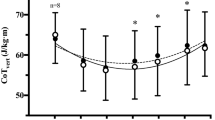Abstract
Purpose
The aim of this study is to describe the effects of speed and gradient during uphill ski mountaineering on energy expenditure, to relate any changes to changes in stride characteristics, and to determine an optimal gradient and speed allowing minimization of energy expenditure.
Methods
11 subjects were tested on snowy trails using their mountaineering skis (fitted with skins), boots and poles, at three gradients (7, 11 and 33 %) at 80 % of maximum heart rate (HRmax), and at 11 % also at 90 and 100 % of HRmax. Energy expenditure was calculated by indirect calorimetry to derive energy cost of locomotion (EC), vertical energy cost (ECvert) and mechanical efficiency, while stride length, stride frequency, relative and absolute thrust phase duration, and slope gradient were measured with an inertial sensor-based system.
Results
At 11 % there was no change with speed in EC, ECvert and mechanical efficiency, while stride length and frequency increased and absolute thrust phase duration decreased. There was an effect of gradient on EC, ECvert and mechanical efficiency, while speed, stride length and stride frequency decreased and absolute and relative thrust phase duration increased. The most economical gradient (lowest ECvert) was the steepest one.
Conclusion
During ski mountaineering uphill at shallow gradient (11 %), EC, ECvert and mechanical efficiency do not vary with speed, while at steeper gradient (33 %) economy is improved. It follows that to minimize energy expenditure and optimize performance to reach a place located at a higher altitude, an athlete should choose a steep gradient, if he/she is able to maintain a sufficient speed.

Similar content being viewed by others
Abbreviations
- ANOVA:
-
Analysis of variance
- EC:
-
Energy cost of locomotion
- ECvert :
-
Vertical energy cost
- HRmax :
-
Maximum heart rate
- HR:
-
Heart rate
- mvert :
-
Vertical meter
- \( \dot{\text V}\)O2 :
-
Oxygen uptake
- \( \dot{\text V}\)O2max :
-
Maximal oxygen uptake
References
Adrian MJ, Singh M, Karpovich PV (1966) Energy cost of leg kick, arm stroke, and whole crawl stroke. J Appl Physiol 21:1763–1766
Ainegren M, Carlsson P, Laaksonen MS, Tinnsten M (2014) The influence of grip on oxygen consumption and leg forces when using classical style roller skis. Scand J Med Sci Sports 24:301–310. doi:10.1111/sms.12006
Ardigò LP, Saibene F, Minetti AF (2003) The optimal locomotion on gradients: walking, running or cycling?. Europ J Appl Physiol 90(3–4):365–371
Fasel B, Favre J, Chardonnens J et al (2015) An inertial sensor-based system for spatio-temporal analysis in classic cross-country skiing diagonal technique. J Biomech 48:3199–3205. doi:10.1016/j.jbiomech.2015.07.001
Fasel B, Praz C, Kayser B, Aminian K (2016) Measuring spatio-temporal parameters of uphill ski-mountaineering with ski-fixed inertial sensors. J Biomech. (online first) doi:10.1016/j.jbiomech.2016.06.017
Formenti F, Ardigo LP, Minetti AE (2005) Human locomotion on snow: determinants of economy and speed of skiing across the ages. Proc Biol Sci 272(1572):1561–1569. doi:10.1098/rspb.2005.3121
Kawamura K, Tokuhiro A, Takechi H (1991) Gait analysis of slope walking: a study on step length, stride width, time factors and deviation in the center of pressure. Acta Med Okayama 45:179–184
Margaria R (1968) Positive and negative work performances and their efficiencies in human locomotion. Int Z Angew Physiol Einschl Arbeitsphysiol 25:339–351. doi:10.1007/BF00699624
Margaria R, Cerretelli P, Aghemo P, Sassi G (1963) Energy cost of running. J Appl Physiol 18:367–370
Millet GY, Hoffman MD, Candau RB et al (1998) Effect of rolling resistance on poling forces and metabolic demands of roller skiing. Med Sci Sports Exerc 30:755–762
Minetti AE (1995) Optimum gradient of mountain paths. J Appl Physiol 79:1698–1703
Minetti AE, Ardigo LP, Saibene F (1993) Mechanical determinants of gradient walking energetics in man. J Physiol 472:725–735
Minetti AE, Ardigo LP, Saibene F (1994) Mechanical determinants of the minimum energy cost of gradient running in humans. J Exp Biol 195:211–225
Minetti AE, Moia C, Roi GS et al (2002) Energy cost of walking and running at extreme uphill and downhill slopes. J Appl Physiol 93:1039–1046. doi:10.1152/japplphysiol.01177.2001
Nilsson J, Thorstensson A, Halbertsma J (1985) Changes in leg movements and muscle activity with speed of locomotion and mode of progression in humans. Acta Physiol Scand 123:457–475. doi:10.1111/j.1748-1716.1985.tb07612.x
Pellegrini B, Zoppirolli C, Bortolan L, Holmberg HC, Zamparo P, Schena F (2013) Biomechanical and energetic determinants of technique selection in classical cross-country skiing. Hum Mov Sci 32(6):1415–1429
Praz C, Fasel B, Vuistiner P et al (2016) Optimal slopes and speeds in uphill ski mountaineering: a laboratory study. Eur J Appl Physiol 116:1011–1019. doi:10.1007/s00421-016-3371-5
Saibene F, Minetti AE (2003) Biomechanical and physiological aspects of legged locomotion in humans. Eur J Appl Physiol 88(4):297–316
Tosi P, Leonardi A, Schena F (2009) The energy cost of ski mountaineering: effects of speed and ankle loading. J Sports Med Phys Fit 49:25–29
Tosi P, Leonardi A, Zerbini L et al (2010) Energy cost and efficiency of ski mountaineering. A laboratory study. J Sports Med Phys Fit 50:400–406
Acknowledgments
This work was supported by the Swiss Federal Office of Sports.
Author information
Authors and Affiliations
Corresponding author
Ethics declarations
Conflict of interest
There are no conflicts of interest.
Ethical approval
This study was performed with ethical approval from a competent body and complied to the international and national standards and legislation for experimental research with humans.
Additional information
Communicated by Jean-René Lacour.
Rights and permissions
About this article
Cite this article
Praz, C., Fasel, B., Vuistiner, P. et al. Optimal slopes and speeds in uphill ski mountaineering: a field study. Eur J Appl Physiol 116, 2017–2024 (2016). https://doi.org/10.1007/s00421-016-3455-2
Received:
Accepted:
Published:
Issue Date:
DOI: https://doi.org/10.1007/s00421-016-3455-2




